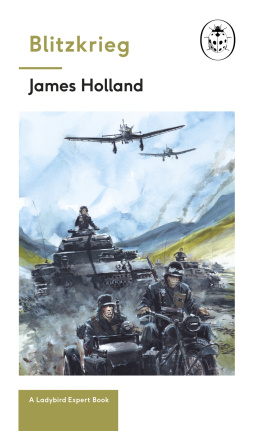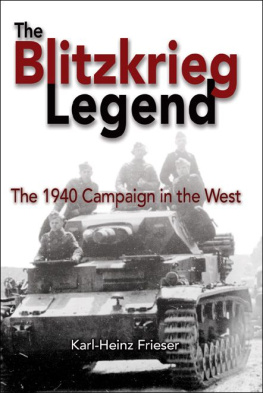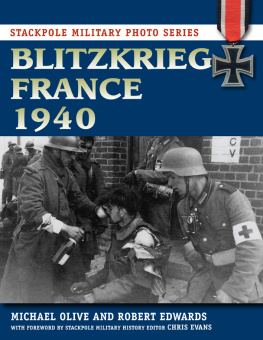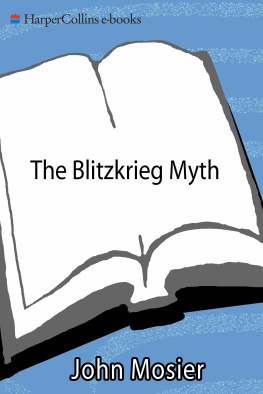The Blitzkrieg Legend

An Association of the U.S. Army Book
The Blitzkrieg Legend
The 1940 Campaign in the West
Karl-Heinz Frieser
with
John T. Greenwood
Naval Institute Press
Annapolis, Maryland
Naval Institute Press
291 Wood Road
Annapolis, MD 21402
2005 by Militrgeschichtlichen Forschungsamt (MGFA)
All rights reserved. No part of this book may be reproduced or utilized in any form or by any means, electronic or mechanical, including photocopying and recording, or by any information storage and retrieval system, without permission in writing from the publisher.
The original edition was published under the title
Karl-Heinz Frieser, Blitzkrieg-Legende. Der Westfeldzug 1940
Munich: Oldenbourg (2nd edition) 1996
(= Operationen des Zweiten Weltkriegs, 2)
First Naval Institute Press paperback edition published in 2012.
ISBN: 978-1-61251-358-4
The Library of Congress has cataloged the hardcover edition as follows:
Frieser, Karl-Heinz.
[Blitzkrieg-Legende. English]
The Blitzkrieg legend : the 1940 campaign in the West / Karl-Heinz Frieser with John T. Greenwood.
p. cm.
Includes bibliographical references and index.
1. World War, 19391945CampaignsWestern Front. 2. Lightning war. I. Greenwood, John T. II. Title.
D756.3.F7513 2005
940.5421dc22
2005016997
 This paper meets the requirements of ANSI/NISO z39.48-1992 (Permanence of Paper).
This paper meets the requirements of ANSI/NISO z39.48-1992 (Permanence of Paper).
20 19 18 17 16 15 14 13 12 9 8 7 6 5 4 3 2 1
First printing
Contents
Charts
When Karl-Heinz Frieser and I began working on an English translation of his Blitzkrieg-Legende: Der Westfeldzug, 1940 (The Blitzkrieg Legend: The 1940 Campaign in the West) back in 1996, we never expected it to take so long to see the finished book. This project began as a cooperative undertaking between the Military History Research Office of the German Armed Forces in Potsdam, Germany, and my former employer, the U.S. Army Center of Military History, where I was then the chief of the Field Programs and Historical Services Division. Since that time, I have become the chief historian for the Office of the Surgeon General, U.S. Army, and the project moved to the Association of the United States Army (AUSA) in 2000. As a result of the support of Gen. Gordon R. Sullivan, U.S. Army (Ret.), president of AUSA and former chief of staff, U.S. Army, and with the encouragement and solid backing of Lt. Col. Roger Cirillo, U.S. Army (Ret.), who heads up the AUSA book publishing program, Karl-Heinz Friesers book is at long last appearing in English.
Mr. Gerald Lewis Geiger, a World War II and Korean War veteran who served in the U.S. Army in Europe and later in the U.S. Air Force, completed the original translation for Schreiber Translations of Rockville, Maryland. Mr. Geigers efforts made possible the editorial work that Karl-Heinz and I then undertook over the next nine years as the project stumbled along like the French army facing Heinz Guderian and his Panzers on the Meuse River in May 1940. Karl-Heinz has been intimately involved in all aspects of the manuscripts preparationhe has read and commented on every page of every revision that I have completed. He has quickly and completely answered every question I have had. His deep, personal commitment to the completion of this work despite his heavy workload as an author and branch chief at the MGFA (Militrgeschichtlichen Forschungsamt) has been the major reason for its successful completion.
Putting Karl-Heinzs German text into publishable English text that is historically and militarily accurate in all its German, French, and English aspects has been an interesting voyage of discovery. I quickly learned that German and American footnoting and bibliographical styles were dissimilar enough to produce significant additional work. I have adopted the standard American practice of a full source citation in the initial note and an abbreviated form thereafter. With sources in German, French, English, and a few other European languages, and citations required in English for all the non-English titles, the editing workload has been significant. Again, Karl-Heinzs assistance has been critical to completing this project. In the end, I believe I was able to resolve most of the issues associated with footnotes and sources. In accordance with U.S. Naval Institute Press style, the footnotes have been converted to endnotes at the back of the book.
The editor and translator are responsible for all insertions in the text that are set off in square brackets, except those in direct quotations, which are the authors interpolations. English translations of foreign words and phrases are given in parentheses.
In the text, ranks of the German personnel are retained in German in their initial appearance while all others are in English. I have tried to minimize unneeded repetition of ranks, so the initial mention of a personality is the only time his rank appears unless subsequently a higher rank was achieved, such as with Erich von Manstein. For the readers benefit, positions or commands held by individuals appear as they did in the original book. A table of German and U.S. Army equivalent ranks is provided.
One of the most challenging aspects of my work was to return to their original English form all quotations from English-language sources that had been published in German or translated into German in the book. This required locating all such original editions cited by Karl-Heinz, if possible, or later editions, if necessary, and replacing each quotation in German with the original English version. This took considerable time and effort. All notes referencing such citations contain both a German-language source, if cited by Karl-Heinz, and the original English source.
German military terms are used sparingly and only when they are particularly critical to the text or are commonly accepted in military history publications, such as Panzer, which is used throughout for armored units and vehicles. Only certain important German units appear in German in the initial appearance and thereafter are in English translation. All Belgian and French units appear in English translation.
All photographs maps, charts, and diagrams from the original German edition have been retained in this edition. However, the text of the maps, charts, and diagrams has not been translated into English due to associated costs that would have affected the books final price. To assist in understanding the untranslated pages, a glossary has been prepared that includes many of the German abbreviations and words contained in the maps, charts, and diagrams.
Karl-Heinz Friesers book is an important contribution to military history and to the twentieth century because it unravels a legend that has stood for more than sixty-five years. His research in the original documentation in the German Federal Military Archives is complemented by wide-ranging research in primary and secondary sources. As he says, his story ranges from Adolf Hitler and the army general staff at the highest strategic and national levels down to the company officers and enlisted men who actually won the victory at Sedan. While telling this multidimensional story, his primary focus remains on the operational level of war where the outcome was decided on the battlefield between the Meuse River and the English Channel in May 1940.
John T. Greenwood
In starting my research on the Westfeldzug 1940 (the 1940 campaign in the west), I naturally went along with the old theory that this campaign had from the very beginning been planned as a so-called blitzkrieg. The approximately fifteen hundred books and essays that I analyzed almost without exception confirmed this generally accepted idea. I was, therefore, surprised when the exact opposite began to emerge with increasing clarity during my archival research. As a member of Militrgeschichtliches Forschungsamt (MGFA, Military History Research Office of the Bundeswehr) I had the opportunity over several years to go through the pertinent files of the Bundesarchiv-Militrarchiv (Federal Military Archives) in Freiburg, specifically from the highest strategic echelon down to, in some cases (as regards the key episodes), the lowest tactical command echelon. This focus resulted in a new perspective. It became increasingly clear that the campaign in the west happened differently from the way it was planned.
Next page










 This paper meets the requirements of ANSI/NISO z39.48-1992 (Permanence of Paper).
This paper meets the requirements of ANSI/NISO z39.48-1992 (Permanence of Paper).